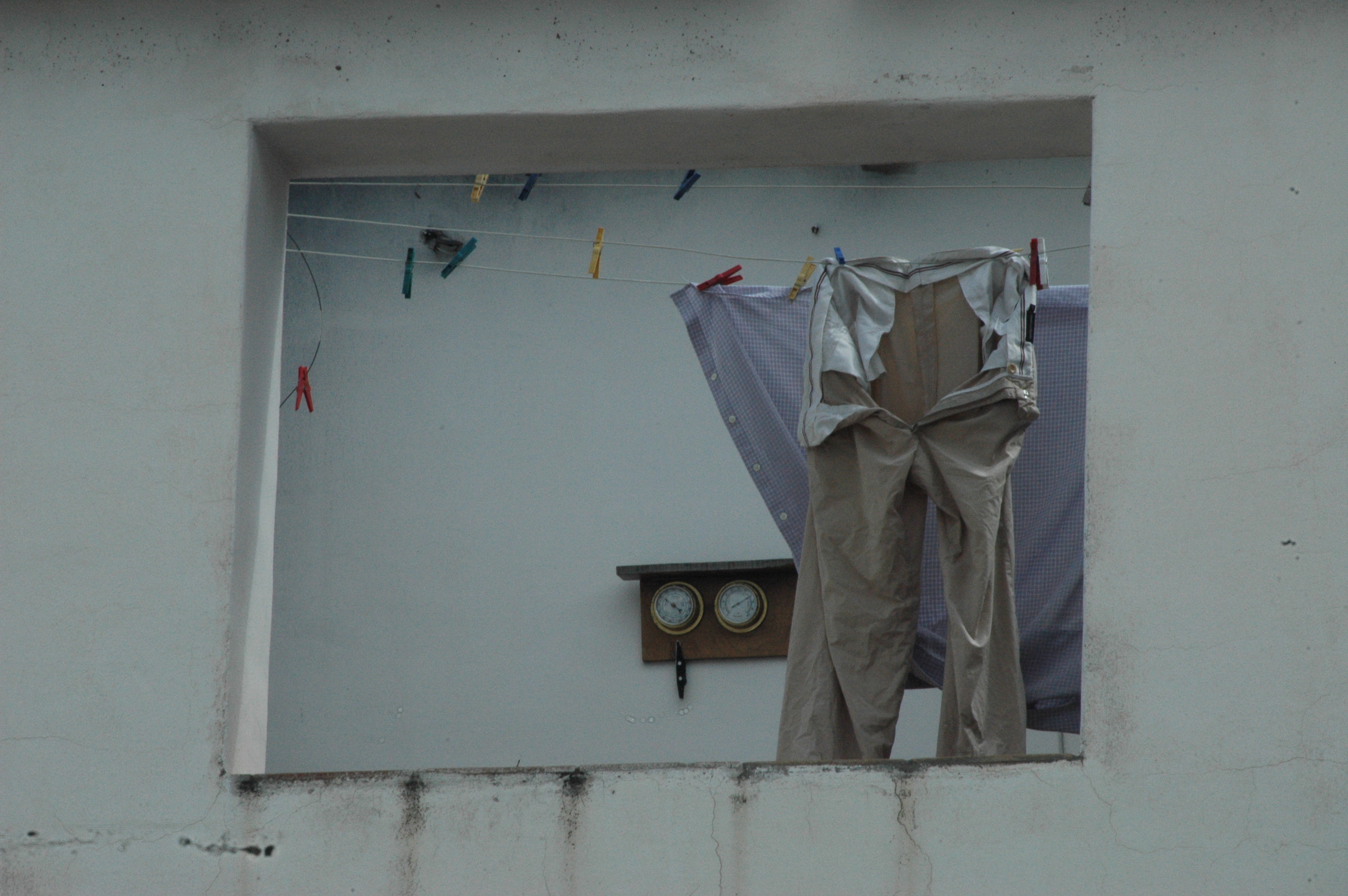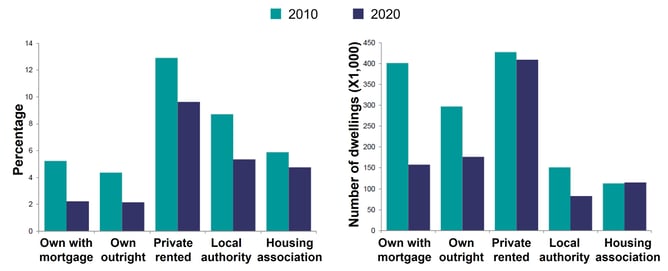
Sensor data inform cost-effective approaches to damp and mould problems. They may be as simply as changing occupants’ behaviour, or they may require renovations to...
Indoor mould occurs when relative humidity is consistently over 80% and an indoor wall is cold enough to cause condensation. Damp is prevented by a combination of heating, insulation or ventilation, all of which incur costs. Damp and mould are most often found in older buildings with poor insulation.
This article is the first in our series on damp and mould in the home. The others are:
Mouldy homes 3: knowledge gaps
Mouldy homes 4: how to dry out damp Britain
Mouldy homes 5: is infrared a solution?
If you’ve spent any time bouncing between rented homes, you’ll have heard the story of the irritated tenants’ final farewell to an unloved landlord. The probably apocryphal tenants repeatedly ask the landlord to do something about the cold and the damp but every time, the landlord shrugs, mutters about how much it would cost and demands their rent. Eventually, the tenants move out but before they leave, they mix a jar of sugared water and use it to write a detailed explanation of how the landlord’s peculiar ancestry led to his improbable anatomy on a wall. Two weeks after the tenants get their deposits back, the message appears in letters of black mould.
It’s become an urban myth because it mythologises a situation that many renters have encountered. In England, one house in every 25 has a serious damp problem but that’s probably the tip of the iceberg. A damp problem doesn’t need to be classed as serious to make a home unpleasant to live in and where there is damp, there is mould. This article will discuss how a home becomes infested with mould and begins a series that will discuss the health problems that lead to and possible solutions available to a homeowner or landlord.
‘Mould’ is a catch-all term for several different species of fungus. The ones that turn up as uninvited house guests tend to be the ones that need a particular set of conditions to grow: they require a hard surface that is habitually damp and shaded from ultraviolet emitted by the sun. In nature, such a habitat would be a site of fierce competition between various fungi which, in turn, would attract all manner of fungus-eating creepy crawlies. In a damp-afflicted house, however, those same conditions occur with far less competition which makes them ideal for any mould that can establish itself.
Hard surfaces and lack of ultraviolet are unavoidable properties of a building’s interior but damp is not. If a home is well designed and well maintained, the interior surfaces will be dry for most of the time. Unfortunately, more than half of British homes are more than 60 years old and more than a fifth have passed their centenary [PDF]. Many of those older homes are in a poor state of repair and a lot of them weren’t very well designed in the first place. That’s why Britain has a mould problem.
There are two elements necessary to get a surface damp enough for a mould:
The thresholds for humidity and surface temperature at which water will condensate and cause damp can be calculated with a psychrometric chart. However, the rather literally titled Modelling Mould Growth project at the VTT Technical Research Centre of Finland found that mould rarely grows at relative humidities below 80 even if the temperature is low enough to enable condensation.
That’s no reason to be complacent. Such high relative humidities do occur in many British homes and if it rises above 95%, the mould can cause lasting structural damage.
The Modelling Mould Growth project showed the relationship between relative humidity and temperature in the plot below.
Damp is the primary factor involved in mould growth but not the only one. Mould can and will grow on any surface if the conditions are right but some surfaces are more prone to mould problems than others. For example, it colonises wooden surfaces much faster than concrete. Stopping it altogether requires getting rid of the damp, which in turn requires an understanding of what causes it in the first place.
In Britain, the relative humidity of outside air is nearly always below the 80% mould threshold [PDF]. Moreover, because relative humidity is defined relative to the carrying capacity of the air which increases with temperature, air moving into a home that is warmer than the outdoor temperature decreases its relative humidity even if it retains the same absolute amount of water vapour. If the relative humidity inside a home has risen above 80%, it can only be because water vapour is being produced and retained inside the home.
Unfortunately, it’s not possible to live in a home without raising its relative humidity because we have to breathe, and every exhalation contains water vapour. Then there’s all the showering, cooking and laundry drying that we do, all of which adds water vapour to the air.
If the home is well ventilated, that threshold will never be reached. Ventilating a home can be as simple as opening a window but that’s not usually an option in the winter, which is when damp problems tend to be at their worst because it is when the temperature difference between the walls and the air is at its highest.
That’s a problem that suggests a solution: stopping the walls from getting too cold. A poorly insulated outdoor wall is likely to be cold a lot of the time, simply because it conducts heat energy into the outdoor air whenever the air is cooler indoors than outdoors. Upgrading the insulation can help to resolve that problem and at the same time, it can dramatically reduce the energy needed to keep the house warm.
A possible problem is that the temperature of an external wall may not be uniform. There may be thermal bridges through any insulation to the outdoors, where the surface temperature is markedly lower than on the rest of the wall. Thermal bridges are often at the centre of mould infestations, as well as providing conduits for a building’s heat energy to escape.
Containing heat within a building is only part of the solution. Turning up the heat has two effects. First, raising the temperature of the indoor air raises the amount of water vapour it can carry which, assuming the same amount of water vapour, lowers the relative humidity. Second, some of the heat energy from the air is conducted to the walls where, if it raises the surface temperature sufficiently, it prevents that water vapour from condensing into damp.
Both the mechanisms behind damp and the potential solutions indicate why damp and mould tend to be at their worst in low-income households. That’s partly because rented homes tend to be in older buildings and older buildings are more likely to be poorly insulated and in a poor state of repair.
 |
|
Percentage (left) and number (right) of dwellings with damp problems in England compared by tenure. Data from DLUHC (2020) English Housing Survey 2020. |
Another reason is that people living on low incomes are often unable to address the factors that exacerbate damp, especially in the context of the high energy prices and high inflation that are causing a cost of living crisis at the time of writing. For example, a low-income tenant may dry their laundry indoors because they do not have access to a washing line and can ill-afford to run a tumble drier.
Similarly, a low income is a good reason to minimise expenditure on heating. In 2020, the government estimated that over 13% of British households were in fuel poverty [PDF], defined as being unable to adequately heat their home without being left below the poverty line. The figure has not been revised using the same definition since then, but there is no doubt that the dramatic energy price rise of 2021 will have made the 13% figure an equally dramatic underestimate. A University of York study showed that the number of households spending 10-20% of their income on fuel has quadrupled since then, while the number spending over 30% has increased by more than ten times.
Given the choice between being cold and being damp, tenants often choose damp by blocking vents during the winter. It marginally improves a home’s heat retention but also retains water vapour, making it more likely that the relative humidity will rise above the 80% threshold.
It has been said that a building’s occupants cause humidity but it’s the building that causes the condensation. In rented properties, that sets the scene for conflict between tenants who occupy the building and the landlord responsible for it. As the next article will discuss, failing to resolve that conflict can be life-threatening for a tenant and is beginning to have consequences for landlords as well.
If you’d like to know more about how the atBOS platform can help address damp and mould problems, ask us on the form and we'll be happy to discuss it.

Sensor data inform cost-effective approaches to damp and mould problems. They may be as simply as changing occupants’ behaviour, or they may require renovations to...